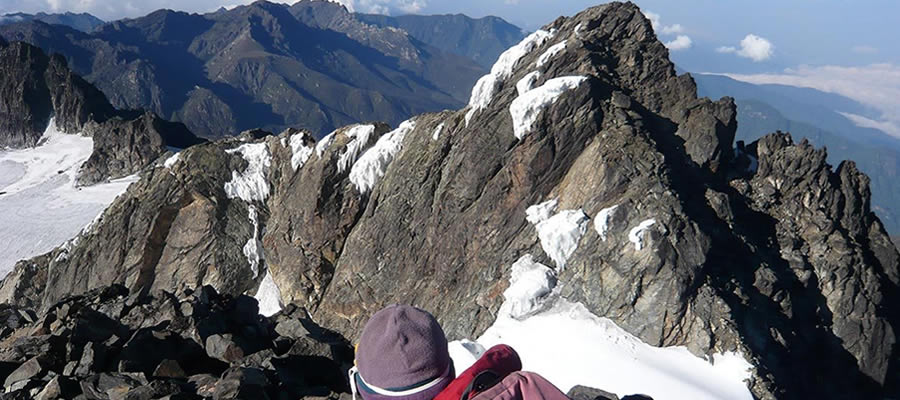Mountaineering & Wildlife Safari Tours Uganda-Mt. Rwenzori National Park
Mountain Rwenzori also called mountains of the moon, major mountain range of East Africa and is shared by two countries Uganda and DR Congo. On Uganda side, it runs along the western edges of three districts of Bundibugyo, Kabarole and Kasese of western Uganda.
Its great mass lies between the western arms of the Great Rift Valley. Its magnificent skyline and spectacular landscapes make it one of the most beautiful physical features of Africa.
Biologically, it is home to the largest trees in the world - the giant lobelia. It has considerable importance as a source of power and water for the surrounding communities.
Physiography
Rwenzori Mountain is an asymmetrical range with its crest and high peaks decidedly toward the west. The peaks range from 15,000 to 16,000 feet (4,627 to 5,109 metres) above sea level, with Mount Stanley, at 16,762 feet (5,109 metres), the third highest peak in the continent.
Much of the rock is granite or a near relative of granite. There are dividing bands of metamorphosed (heat- and pressure-altered) sedimentary rock—all that is left of a once extensive sedimentary basin—and some large areas of extrusive rock, especially from river Mubuku southwards.

Geology
It has long been recognized that the mountain Rwenzori is an up faulted, tilted block of the Earth’s crust. A major fault zone bounds the block on the west, and it was along this that the great mass that became the Rwenzori was uplifted. Between its flanks, streams flow more gently down the geologic dip slopes, creating massive alluvial fans that encroach into the western Valleys of Uganda.
Drainage
The gentler east-facing slope has been dissected by a series of long streams. Such rivers as the Mubuku, Nyamwamba, Sebwe, originate in deep valleys carved largely by glaciers into the predominant granite. All these rivers pour their water to Lake George.
Plant life
There is no water shortage in the Rwenzori; yet, several members of the afro alpine family resemble species that normally thrive in desert climates. The reason lies in their similar water economy. Water is not always readily available to the afro alpine plants when they need it. In addition, nightly frosts affect the sap transport in the plants and the intake of water by its roots.
As the day begins, the air temperature and radiation level rise rapidly, putting strenuous demands on the exposed parts of the plants as they try to meet the transpiration demands of the leaves and maintain a proper water balance. To counter the effects of freezing, the afro alpine plants have developed the insulation systems that give them such a striking appearance. These adaptations become more prominent as the altitude increases.
Animal life
The lower mountain ranges are home to about 70 various mammal species and 217 bird species of which six are Albertine Rift endemics, 4 of which are endemic to this part only plus three other rare in addition to 3 rare species.
Other mammals living within are: the Rwenzori otters, chimpanzees, elephants and leopards. Despite the fact that wild animals are not commonly seen inside the dense forests of this park, be on the watch for different primates such as the black and white colobus monkeys, the blue monkeys and the Angola colobus, in addition to small antelopes like bushbucks is not easily seen within the thick forest.
The people
There are three ethnic groups that have lived on the western slopes of mount Rwenzori since the time of mass movement of people between the 12th and 16th centuries. The Bakonzo in Kasese, the Batoro in Kabarole, and the Bamba in Bundibugyo are the people who stay around the foothills of the Rwenzori mountains and basically carry out farming.
Activities to Do in the Park
There are various things to do on mount Rwenzori which has a lot to offer to its visitors and these include the following;
Hiking
Hiking is the major activity in the area. The hikes go from 1 to 12 days. To reach the summit (Margherita peak), you will need from 6 to 12 days depending on the hikers speed and fitness.
There are trails you can follow to reach the summit of mount Stanley; the central circuit trail and the kilembe trail. Apart from mount Stanley, you can as well hike the other mountains like Baker, Speke, Emin among others.
Birding
There are also birding opportunities in Rwenzori and are mostly found in montane forest, some of the few species are found in the unreceptive world of the high Rwenzori. Some of the bird species include; the bee eaters, sun birds, Robins, Barbets and these are some of 217 species found in Rwenzori Mountain National park. The other bird species to view here include; the long eared Owl, Rwenzori Turaco and higher in the slopes, you can view species including; beared Vultures, swifts as well as the black Eagles that may be circled for the prey.
Forest walks
There are various trails in the tropical rain forests which can be followed by tourists whilst visiting the Rwenzori area. Even though you don’t hike up to Margherita peak, you can as well take these trails and have a clue of what the Rwenzori Mountains have to offer. During this activity, you will spot various bird species that live in the forest and animals like elephants and various antelope species among others.

